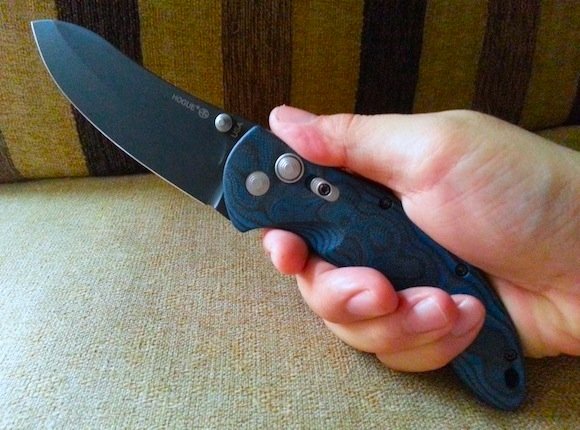This is a collage of the Hogue EX-04 with Upswept Blade in Blue Lava G-Mascus, with photos and description of this knife.
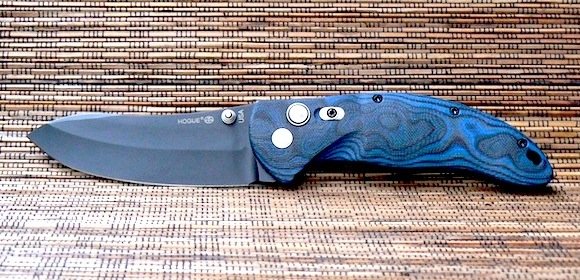
![]()
I first came across a photo of the Hogue EX-01 online (the exact photo I first saw as shown at right), and thought the entire knife to be very well designed, beautiful even (still a very beautifully designed folder in my opinion which I would buy with spare cash).
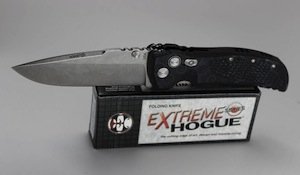
Having looked at knives with a keen interest for 30-plus out of the 40 years of my life, I was surprised that the name Hogue didn’t ring a chord. And the reason for that was up until recently, Hogue was mainly involved in the production of gun grips and other items in the firearms industry, and only made their foray into knife production in the last few years.
Coincidentally, I had also stopped any research on new knives in the last 5 years or so. Not surprisingly then, for someone who lives in a country that deems firearms to be illegal, the name Hogue would be quite unfamiliar. Here in Malaysia, we don’t look at guns or read about them as much as our American friends do, I presume.
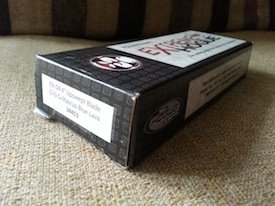 |
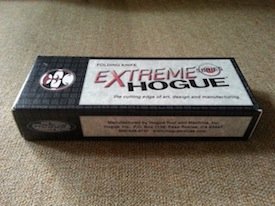 |
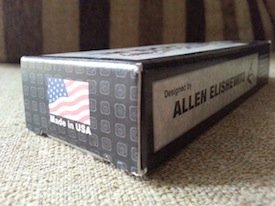 |
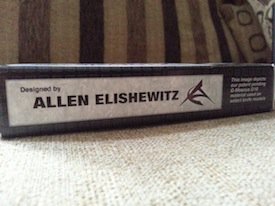 |
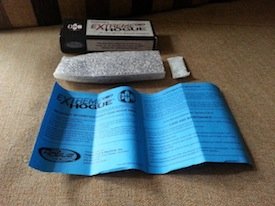 |
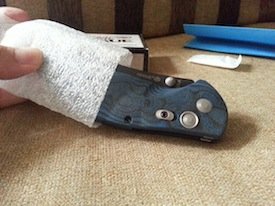 |
DIMENSIONS:
- Overall: 22.8 cm (9.0 in)
- Weight: 161.0 g (5.68 oz)
BLADE:
- Blade Length: 9.8 cm (4.0 in)
- Thickness: 3.8 mm (0.15 in)
- Material: 154CM
- Blade HRC: 57-59
- Finish: Gun-KoteTM, black
- Grind: Double Hollow Grind
- Style: Upswept
- Edge: Plain
- Deployment: Thumb Stud, ambidextrous manual
- Lock Type: Button Plunge with Safety
HANDLE:
- Length: 13.0 cm (5.0 in)
- Thickness: 16.8 mm (0.66 in)
- Material: G-10
- Style: Blue Lava G-Mascus
POCKET CLIP:
- Style: Spoon, bent
- Finish: Gun-KoteTM, black
- Configuration: Tip-down only
The Hogue EX-01 was priced at about US$200, and although considered reasonably priced for the American market, I considered it too much when converted to my currency. RM740 just seemed like a lot of money to pay for a brand I had not heard of only until then.
Most of the folding knives I then own from knife manufacturer names like Cold Steel, CRKT and Spyderco were at the most about US$100 to US$120. The idea of buying a Hogue quickly dissipated at the thought of the daily lunch meals over a period of about two to three months I could get with one folding knife. Yes, it’s that insane!
As I scoured online for new knives to add to my collection over the last few months, I kept running into Hogue knives on my screen, whether it was on eBay, on YouTube, or simply on personal knife review blogs. Call it subliminal marketing!
A few days of information download and I found out that Hogue had actually released 4 models in the Extreme series over the last few years, culminating in the EX-04 a couple of years back.
Now, when I saw the EX-04 in an online review for the first time, I thought the knife was quite odd. It seemed like a knife you’d either love entirely or hate altogether, and I was in the latter camp.
It is quite a deviation from the other three knives in the Extreme series. While the EX-01, -02, and -03 had mostly straight lines in their designs, the EX-04 was taking “curvaceous” to a bold level.
One may say it’s too sexy for a mean object like a knife. We don’t seem to have a problem with other coveted objects like supercars, watches and laptops being sexy (Apple products come to mind!)…we shouldn’t have a problem with a knife being sexy I guess.
I started finding more about this knife, and the more I researched it, the more I began to find reasons to like it.
Blue Lava G-Mascus G-10 Handle
First and foremost, the linerless handle is beautifully crafted. This is probably the first thing about the knife that you will notice.
I happen to like G-10 scales and handles for my folding knives, and the multi-layered three-tone G-10 on the EX-04 is contoured down to reveal what is termed by Hogue as the G-Mascus Lava pattern, which simulates Damascus patterns on steel.
And like Damascus blades, the handle on each EX-04 seems to be unique and carries its own signature pattern not repeated in another EX-04, even though this is a production knife and not a custom one. I gather this from the many EX-04 I came across online, and every EX-04 I saw had its own distinctive G-Mascus pattern – almost like it was material of natural origin like wood or staghorn.
Some people may find this superficial, but I think it is an important feature in production knives where they are all normally expected to look the same inside out. Here itself is a form of personalisation in a production knife, straight from the manufacturer.
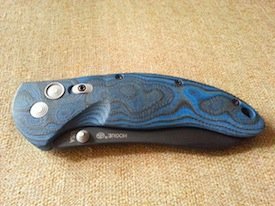 |
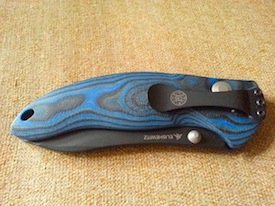 |
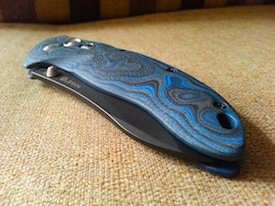 |
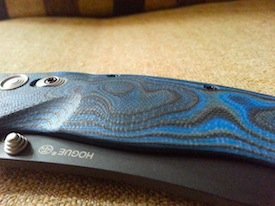 |
On closer inspection, the G-Mascus takes on a sheen and scaly texture quite akin to that of a snake. Or lizard. At least, that was my observation.
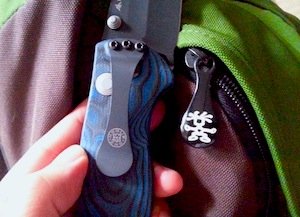
The G-Mascus provides a comfortable level of grip without being overly aggressive on contact, in comparison to the G-10 on some knives such as the Cold Steel Hold Out series.
There is much to praise about the contours on this handle – it seems to be carved at all the right places, such that it rests comfortably in the palm of your hand, whichever way you grip and hold the knife.
The spoon clip is also bent at the right spots so that it doesn’t get in the way of your fingers, whether the knife is held in the left-hand or right-hand, with a hammer-, sabre- or reverse-grips.
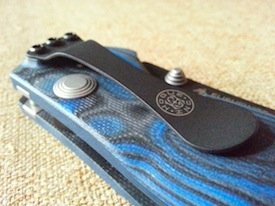 |
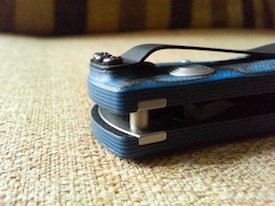 |
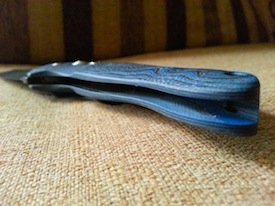 |
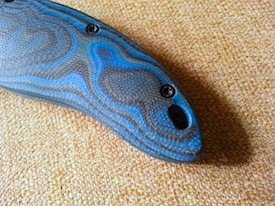 |
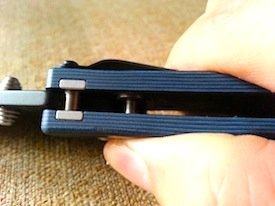 |
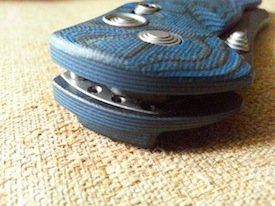 |
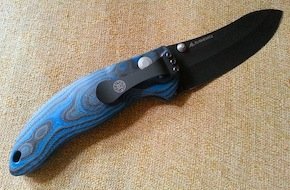
I am also one who is not too fond of very bold curves on my handle, and was worried that the EX-04 would be too curvy on the handle towards the pommel end like my Kershaw Freefall Tanto, which I had found to be a little uncomfortable if held with the way I usually hold my knives.
In fact, this was the first thing I tested when I got hold of the EX-04, and while I’m glad that the drop curve on the handle rear of this knife isn’t as steep and fits very nicely in the palm when held with the hammer-, saber- or reverse-grip, it doesn’t feel quite as comfortable when held in the modified saber-grip, which is the way I normally do (thumb pad flat on handle surface) – see illustrations below.
It may not be a practical way to hold knives, but it’s one I’m accustomed to. Still, it caters well to the other three grips, which is the way most people handle their knives anyway.
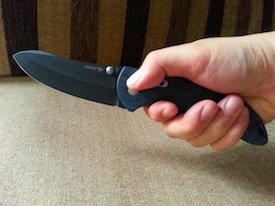 Great! |
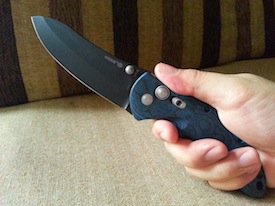 Excellent! |
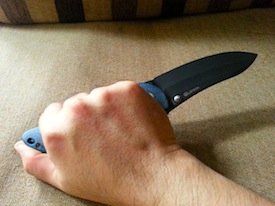 Perfect! |
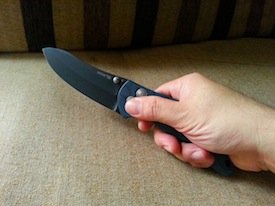 |
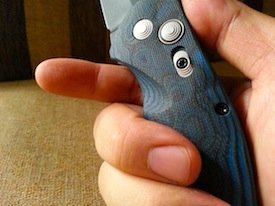 |
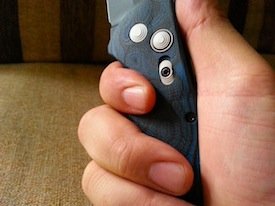 |
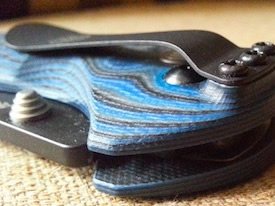 |
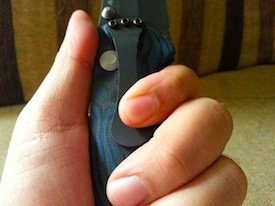 |
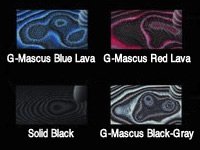
The G-Mascus handle comes in three standard flavours – red, black-gray, and blue – and a special more expensive edition in solid black, for those who find lava patterns too distracting.
I was initially drawn to the black-gray, and thought it looked its part as a tool for the outdoors, without looking too funky. But the G-Mascus itself is an artistic creation, and I eventually felt that the Blue Lava brought this element out the most, and ultimately bought this as my colour choice.
The solid black certainly looks like it means serious business, but the special “almost no two are alike” Damascus pattern is lost in it. That’s fine if you don’t fancy that sort of thing like I do.
OK, enough about the G-10 handle. That was certainly a lot to talk about…just on handles!
Modified Drop Point Upswept Blade and Plunge Lock
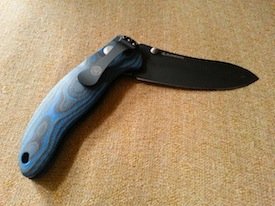 |
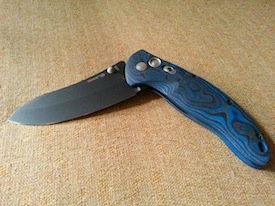 |
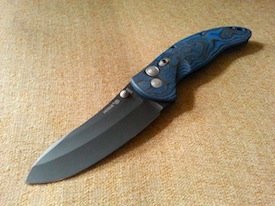 |
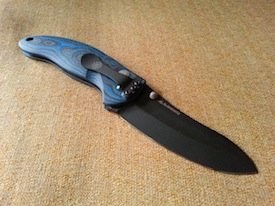 |
Now this is something that beckons attention. It is at this point that I should mention the name Allen Elishewitz.
Mr Elishewitz is a knifemaker who is involved in the design of knives by Hogue, especially on the blade designs, lock mechanisms and other crucial aspects of the knife. More about Allen Elishewitz in the inset box at right and below.
The Upswept blade design as seen in the photos above and below is actually a modified drop point blade, with a unique “upswept” curve that runs with a swedge towards the tip.
Seen from above, the swedge aids in gradually easing the lines from the thickest part of the blade along the spine near the handle, to the narrower region near the tip.
The blade is secured in the open position by a plunge lock, which is released by depressing a push-button. A wide barrel or cylinder along the line of the plunge lock finds its place in a matching notch on the blade.
Pushing the plunge lock downwards disengages the cylinder from the notch, freeing the blade and allowing it to swivel to a close. Interestingly, the cylinder also serves as the detent for the blade in the close position – a detent which is strong and holds the blade closed tightly.
ABOUT ALLEN ELISHEWITZ

– Allen Elishewitz
Hogue, Inc. worked with custom knifemaker Allen Elishewitz to combine art, design and joint manufacturing expertise to deliver a fresh, new innovative approach to sporting cutlery. Successful knife designers usually come from one of three backgrounds: custom knifemaker, martial arts or the military. Elishewitz […] is rather unique in that he has a background in all three.
Elishewitz started martial arts when he was 10, and has trained in Thailand, Taiwan, Greece, and the United States. He has studied more than a dozen different styles including Boxing, Karate, Kali and Thai Boxing. He joined the Marine Corps after high school where his first military occupational specialty (MOS) was as a Naval/Artillery Call for Fire Scout; he was also a Recon Marine.
Elishewitz has been self-employed solely in the knifemaking business for more than 20 years. During this time he has made a lot of different fighting knives, from fixed blades to folders, testing them to see which would perform best. By doing so, he was able to develop a foundation and an understanding of what a true military/defense knife should be. Elishewitz says that as a knifemaker, tactical and defensive knives are what define him and are a natural extension of his personality. He believes that his past experiences gave him the knowledge and the understanding of what a knife needs to possess in order to perform best in a self-defense or military application.
– excerpt from Knives Illustrated Buyer’s Guide 2013
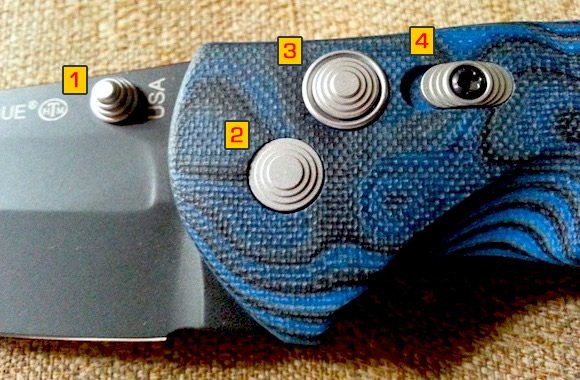 Notice that all four features are consistent in design – four-tier concentric circles or part thereof. These resemble a part of a handgun I have seen before, cannot remember which. |
|
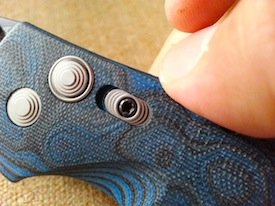 |
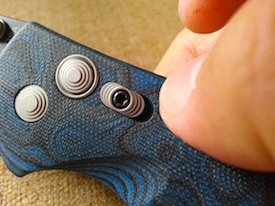 |
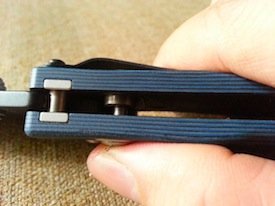 |
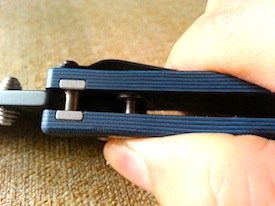 |
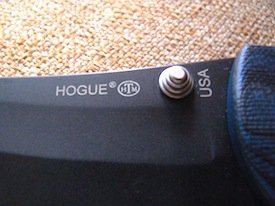 |
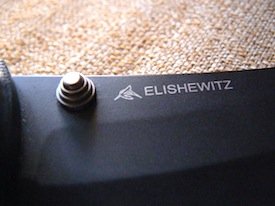 |
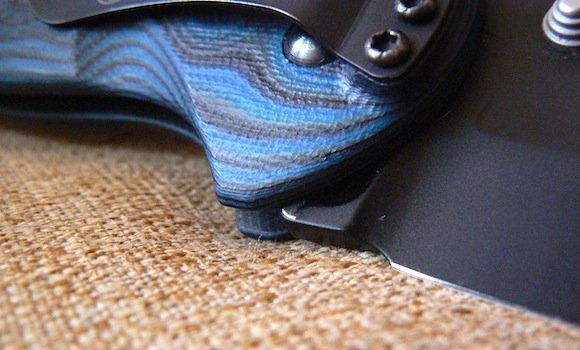 |
|
The plunge lock did sometimes stick during use, which required a harder press on the button than normal to disengage the lock on the blade. This, I hope, will lessen with use, as the knife is run in and the points of contact wear down a little and become smoother.
Blade Material and Treatment
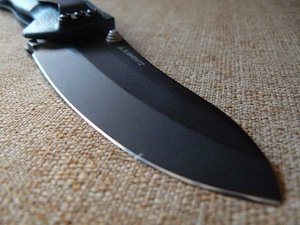
The Hogue EX-04 uses a respectable 154CM high-grade stainless steel for blade material, a Crucible Industries production and is the American version of the Japanese ATS-34 later produced by Hitachi Metals.
154CM is a popular steel selection in Benchmade knives, and has good edge retention and wear resistance. In the Hogue EX-04 and others in the Extreme Series, the 154CM is further treated cryogenically to convert austenite in the steel to martensite which is of harder crystalline structure, resulting in a stronger and stiffer metal.
Blade Profile and Size
Another innovation on the blade is its double hollow-grind profile, which serves to reduce material drag during the cutting process.
This is usually achievable with thinner blades, but the double hollow-grind on the Hogue EX-04 accomplishes this without compromising on blade strength and rigidity.
There were some complications in the making of these grinds on a production blade, which led to the delay in the release of this knife. It was understandably quite difficult to implement consistently on a large scale, but as it turned out, Hogue and Allen eventually succeeded making it a reality, and beautifully executed at that!
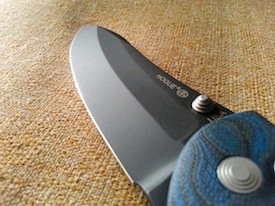 |
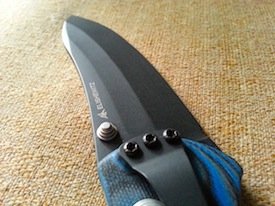 |
The EX-04 comes in 2 sizes – blade lengths of 3.5 and 4.0 inches.
Having in possession folding knives from blade lengths of 2.5 to 5.0 inches, I personally prefer knives in the upper limit of the 3.5-to-4.0-inch range for an EDC.
Most of the online reviews I came across prior to buying the Hogue also claimed that the 4-inch somehow fits better in the hand.
Nevertheless, the 3.5-inch option is there for those who prefer something smaller and lighter, and don’t appear too menacing when deployed for daily cutting activities.
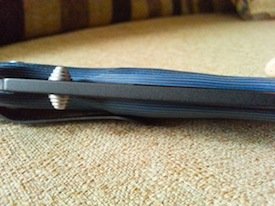 |
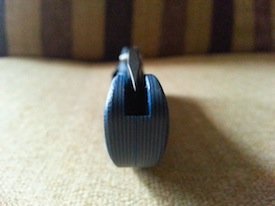 |
Based on personal preference from experience, I ultimately selected the 4-inch version of this knife because it is a size that is large enough for me to comfortably carry and use. Also, simply because my kiasu-ness nature demands that I carry the bigger blade.
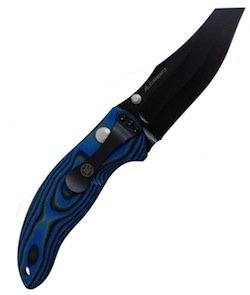
Aside from size difference, the EX-04 also comes in two different blade styles – this Upswept Drop Point, and a modified Wharncliffe (right). I chose the Upswept as I was in the market for a drop point blade.
Furthermore, I found the Wharncliffe a little too quirky for my taste, although many who own it love the design dearly and swear by its effectiveness.
Both blade styles are finished with a black coat of Gun-Kote. I had not read about this anywhere at that time, and was fortunate to be informed about it by Allen himself in one of our correspondences.
I personally prefer my knife blades to be uncoated, for the glint of steel to be obvious. However, for some technical reason, it seems the double hollow-grind on the blade requires it to be coated, and that seems to take precedence over the finishing preference of the blade – a case of function over aesthetics.
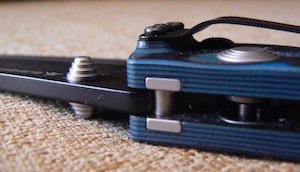
Surprisingly, the Hogue EX-04 does not sport any jimping on the blade spine, a first in deviation in the Extreme Series of Hogue folders – the EX-01, -02 and -03 were all designed with jimping. The reason for this is not known, but I suspect it is to do with the way this knife was crafted and designed.
It is a work of art, with smooth sweeping curves and beautiful lines that would otherwise be marred by jimping and other unnecessary embellishments. Jimping isn’t really a necessity for me in this case, and I would certainly prefer the knife to be as aesthetically pleasing as it is functional in a minimalistic fashion.
It is easy to imagine how jimping would detract from the overall beauty of this knife, with the blade closed or open.
Other Photos of the Hogue EX-04
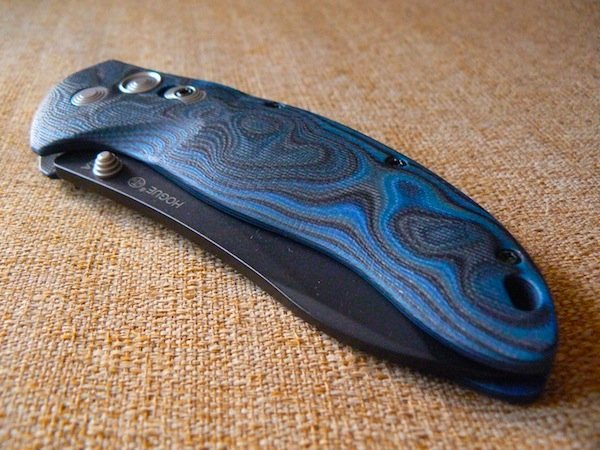
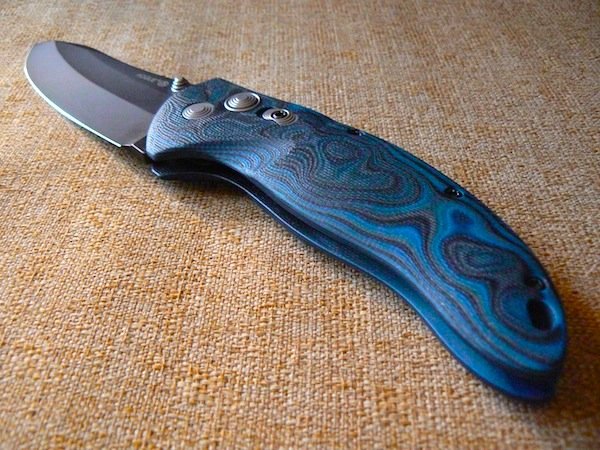
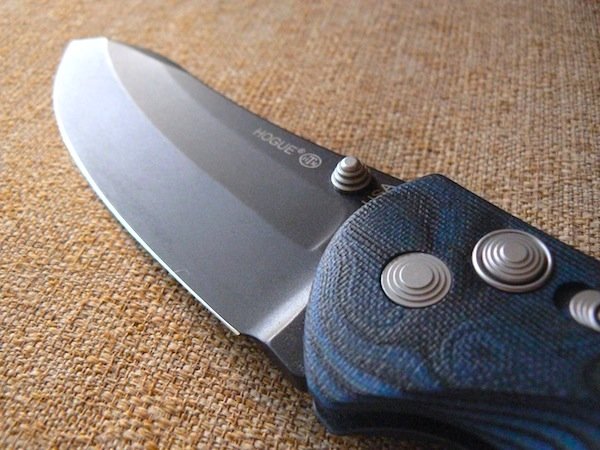
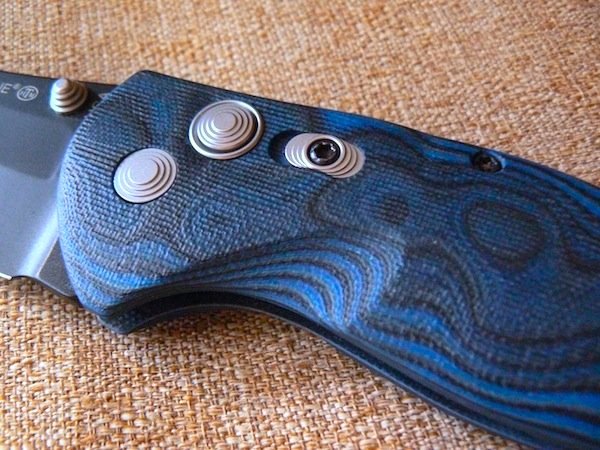
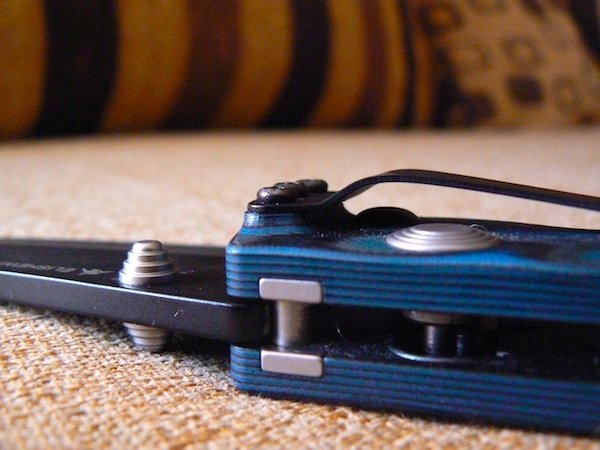
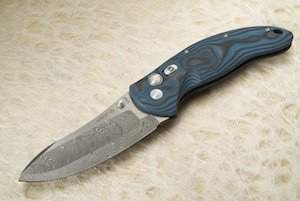
I had come across a Damascus steel version of this blade in one of Allen’s blog post, and enquired about it. Allen told me that those blades were a special run he did for Hogue for the Blade Show a couple of years ago, and doesn’t produce them on request.
This is quite unfortunate, as a Damascus steel version of this Upswept blade would have made the Hogue EX-04 the more ideal knife for me. Uncoated steel, with stainless Damascus patterns on a blade – traits I truly desire on my blade of choice currently.
What Others Have to Say About the Hogue EX-04
The following are video reviews done by Blade HQ and The Edge Observer – the people who bring great reviews on knives and cutting tools.
Technical Notes by Allen Elishewitz on the Hogue EX-04
These are some of Allen’s technical notes on the Hogue EX-04 in four parts, including the how and why the blades on this knife look the way they are.
Conclusion
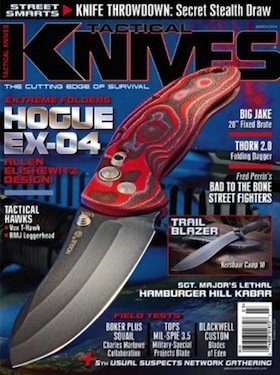
The Hogue EX-04 Upswept counts as a premium production knife utilising well-regarded steel fused with an artistic yet highly functional handle, a strong offering from Hogue which retails at US$259.95. It is at the upper limit of production knife prices; expensive…but easily justified by the beauty and thought that went into its design and creation, not to mention the complexities in getting the required consistency in implementing the double hollow-grind in a production knife. It took a while in the initial stages, but Hogue and Elishewitz successfully achieved this in the end.
Personally, I do not fancy black coat finishing on any blade on my knives; in this case, the coat gives the 154CM steel a layer of molybdenum disulfide protection. While it does give the steel self-lubricating properties, I am just worried about how a worn black finish would look after the blade is put through some hard and harsh paces. I suspect this wear and tear will be something not easily maintainable or restorable by the layman end user.
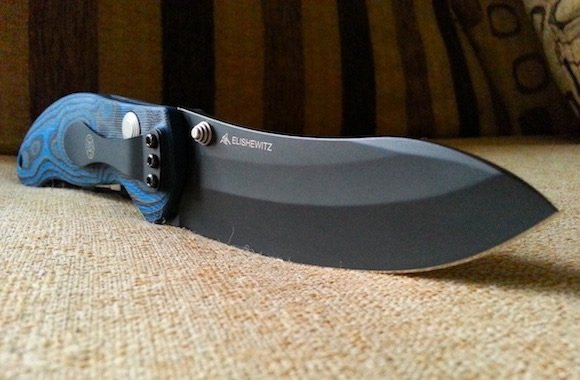
– art, craftsmanship, beauty and versatility in a single practical and functional package.
The elegance of the Hogue EX-04 is obvious even before the blade is opened, and is further enhanced when the blade is fully deployed.
At 161 grams for a 4-inch folder, the Hogue EX-04 is considered light, largely due to its lightweight G-10 frame, thus giving the knife a slightly blade heavy feel.
I personally favour this, for I prefer the weight to be inclined towards the business end of the knife. And, the business end does indeed cut and slice well – I’ve run it through paper, plastic and cardboard material in the course of work.
The Hogue EX-04, which is available on Amazon, is one of my EDC of choice, especially when I need a large blade which is comfortably portable weight-wise as well.
It is a beautiful knife and did, after all, garner the American-made Knife of the Year at the Blade Show 2013 Awards.
